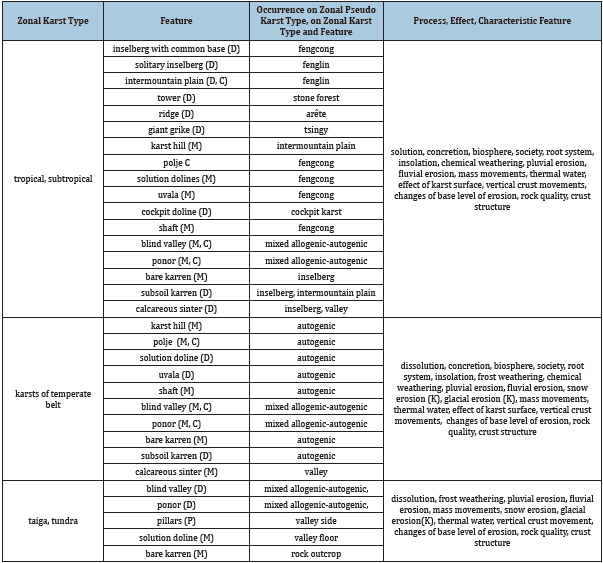- Submissions

Full Text
Environmental Analysis & Ecology Studies
Feature Diversity of Zonal Karsts
Márton Veress*
Department of Geography, Eötvös Lóránd University, Hungary
*Corresponding author: Márton Veress, Department of Geography, Eötvös Lóránd University, Szombathely-9700, Hungary
Submission: March 19, 2021; Published: December 03, 2021

ISSN 2578-0336 Volume9 Issue3
Abstract
A relation was determined between the distance of zonal karst types from the Equator and the diversity of their features.
Keywords: Zonal karst type; Feature diversity; Distance from the Equator
Introduction
The determination of karst types by their environment through their feature diversity is
described here. Based on their characteristics, karst areas can be categorized as karst types.
Researchers have distinguished and described various karst types [1-6]. Karst types can be
classified as zonal and azonal groups [7]. Zonal karsts are climate dependent (e.g., tropical
karst). Azonal karsts occur in the area of zonal karsts, but they are more or less independent
due to any of their characteristics (for example according to rock quality karst can be of
evaporate type or carbonate karst type under any climate).
The characteristics, the features, and the processes of a karst type are more or less different
from other types. Table 1 includes the above-mentioned characteristics of various zonal karst
types. It can be established that on the Earth, the feature diversity on zonal karst types being
closer to the Equator is greater than farther from it. However, the number of processes and
effects being present in their area first increases farther from the Equator (Temperate Belt)
then it decreases (Cold Climate Zone).
The reason for the increase of feature diversity is that dissolution intensity increases
towards the Equator which can be traced back to the increase of biogenic CO2 production.
Since under temperate climate the larger number of processes and effects does not change
this fact either, this indicates that dissolution is the predominant process which is responsible
for the development and state of the phenomena of karst areas prevails over other geomorphic
process on the karsts [8].
Table 1: Solution and partly solution surface karst features and processes on zonal karst types.

References
- Grund A (1914) The geographical cycle in the karst. Gesellschaft für Erdkunde 52: 621-640.
- Cvijič J (1918) Underground hydrography and morphological evolution of karst. Revue de Geographie Alpine 6(4): 375-426.
- Gvozdetskiy NA (1965) Types of Karst in the U.S.S.R. Separatum, Prob Speleol Res (Prague): 47-54.
- Sweeting MM (1973) Karst Landforms, Columbia University Press, New York, USA, p. 362.
- Jakucs L (1977) Morphogenetics of Karst Regions. Adam Hilgar, Bristol, England, p. 284.
- White WB (1988) Geomorphology and Hydrology of Karst Terrains. Oxford University Press, New York, USA, p. 464.
- Veress M (2020) Karst Types and Their Karstification. Journal of Earth Science 31(3): 621-634.
- Cvijič J (1925) Morphological types of limestone soils. CR Acad Sci, Paris, France.
© 2021 © Márton Veress. This is an open access article distributed under the terms of the Creative Commons Attribution License , which permits unrestricted use, distribution, and build upon your work non-commercially.
 a Creative Commons Attribution 4.0 International License. Based on a work at www.crimsonpublishers.com.
Best viewed in
a Creative Commons Attribution 4.0 International License. Based on a work at www.crimsonpublishers.com.
Best viewed in 







.jpg)






























 Editorial Board Registrations
Editorial Board Registrations Submit your Article
Submit your Article Refer a Friend
Refer a Friend Advertise With Us
Advertise With Us
.jpg)






.jpg)














.bmp)
.jpg)
.png)
.jpg)










.jpg)






.png)

.png)



.png)






